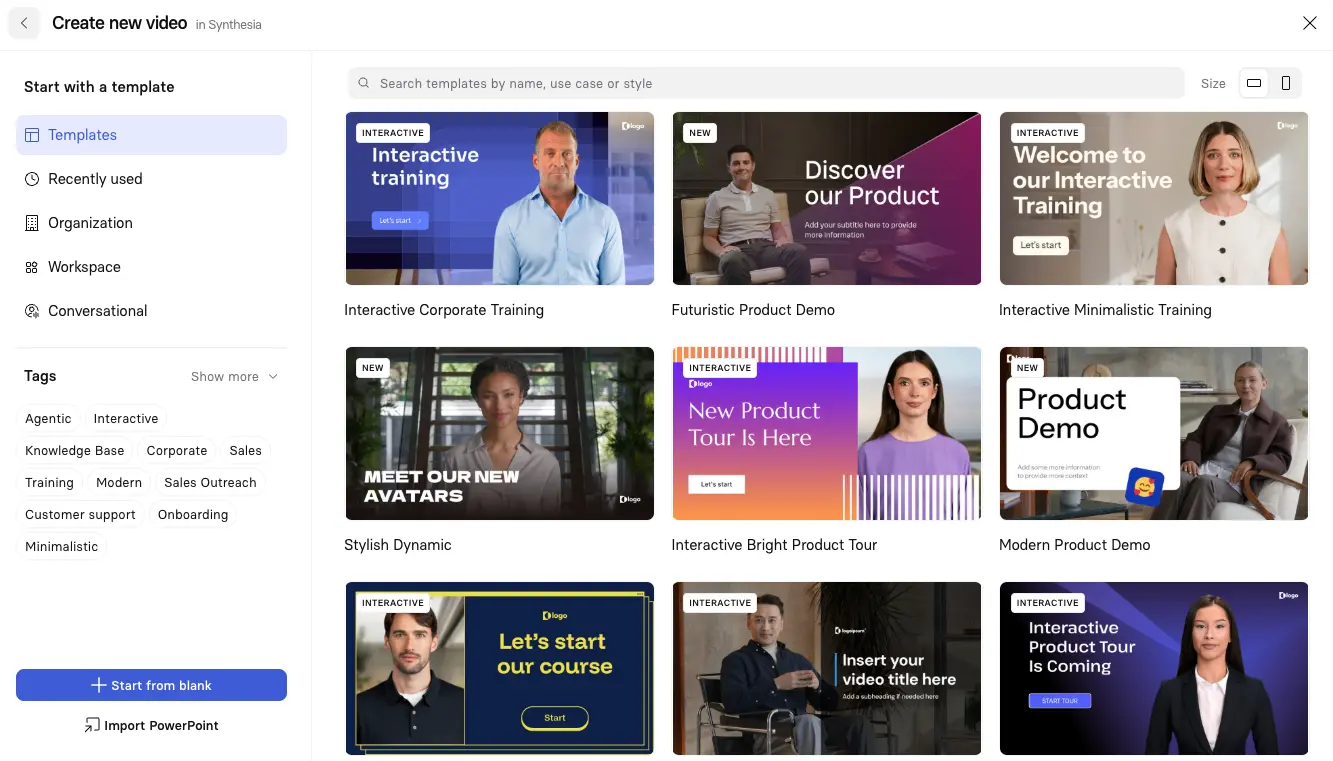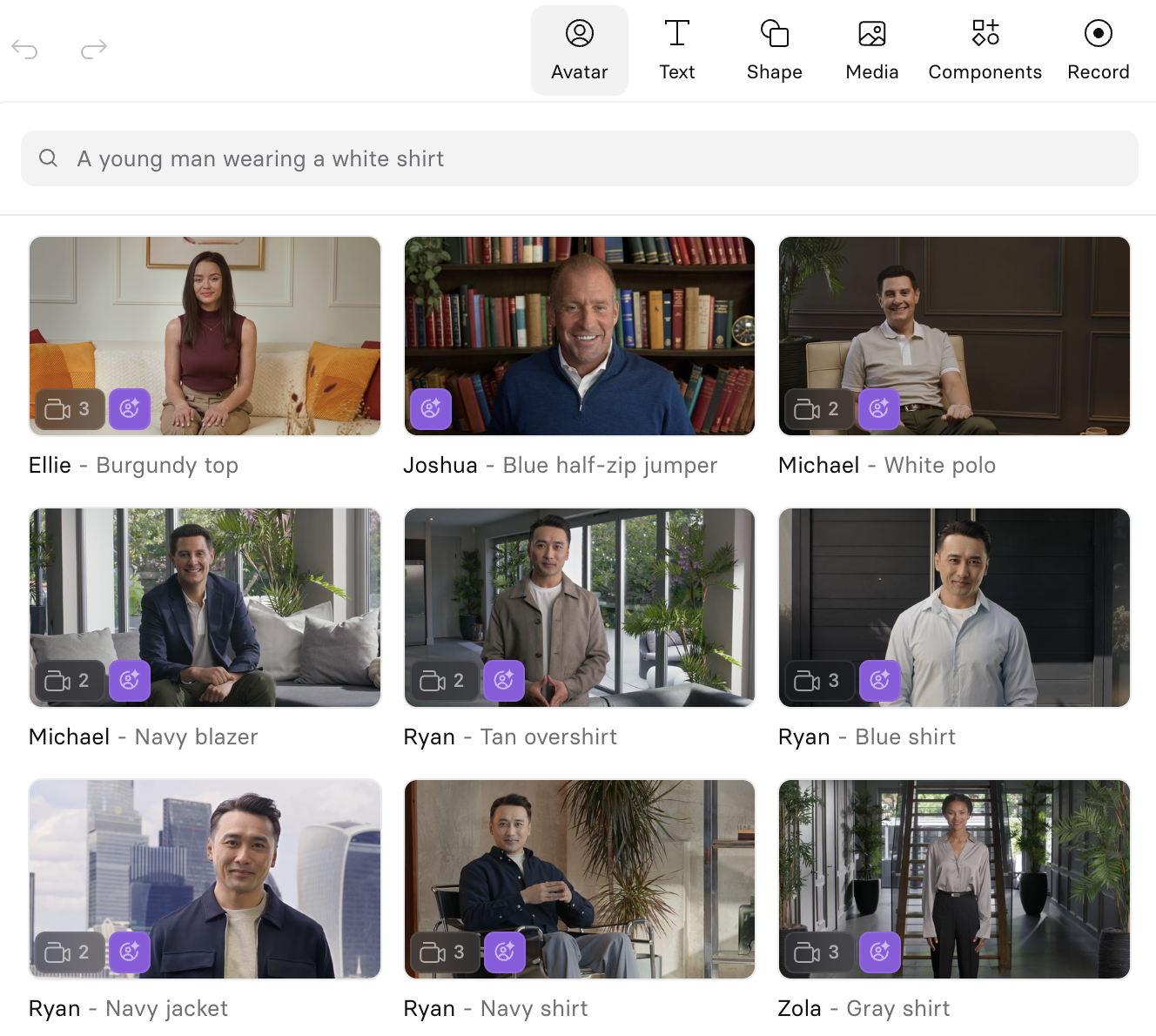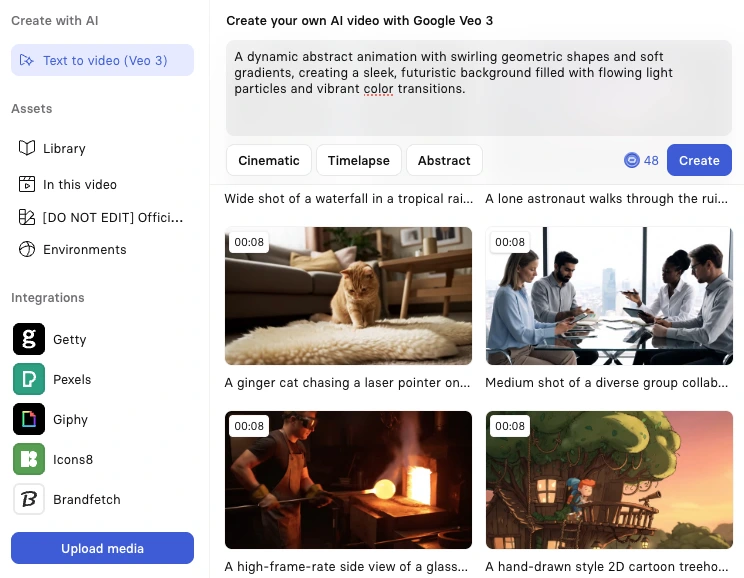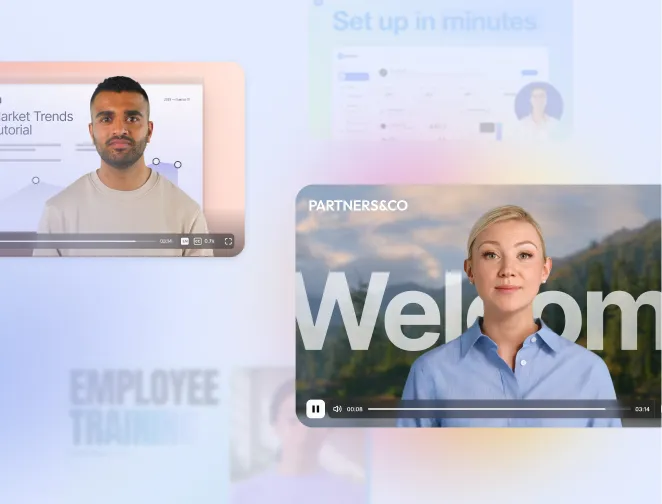
Create AI videos with 230+ avatars in 140+ languages.
Convert Word documents into engaging AI videos in 140+ languages.
I often find myself staring at training documents that no one wants to read.
If that sounds familiar, you're not alone. Many L&D teams face a similar problem, and need a way to turn dense text into content people actually finish.
Synthesia lets me convert Word documents (as well as PowerPoint slides, PDFs, and more) to video in minutes. It's fast to update, easy to localize, and consistent with our brand. What took days now takes minutes, and the results look super professional.
Since implementing these AI-created videos using this doc to video conversion approach, the results have exceeded my expectations:
- 64% increase in training material engagement (measured by completion rates)
- 50% reduction in follow-up questions from new hires during onboarding
- 3 hours per week saved on repetitive training sessions
- 40% faster time-to-productivity for new team members (they report feeling confident in core tasks within 2 weeks instead of 3-4 weeks)
Our international team members specifically mentioned that having captions and the ability to replay sections made the training much more accessible than our previous text-heavy approach.
Your results will vary based on audience and topic, but we saw the biggest gains where the original content was long, dense, and frequently referenced.
1. Prepare your Word doc for video conversion
I think it's worth spending a few minutes rewriting key sections into a more natural script format. Here are the specific transformations I make:
Structure for scenes:
- Use clear headings that can map 1:1 to scenes; one idea per section
- Write the 1–3 takeaways at the top of your doc; each should become a short scene
From documentation language to conversational language:
- Instead of: "employees must complete form A-12 before proceeding"
- I write: "First, you'll need to fill out the A-12 form, which takes about two minutes"
From dense paragraphs to bite-sized chunks:
- Instead of: "The new workflow process has been designed to optimize efficiency by reducing redundant steps while ensuring compliance with company policies and maintaining data integrity throughout the customer service ticketing system"
- I write: "Our new workflow cuts out extra steps. You'll create tickets faster while keeping everything secure and compliant"
Add stage directions for visuals:
- "Click the New Ticket button [show screenshot of dashboard with button highlighted]"
- "Enter a clear title [zoom on title field]"
It's best to try and simplify complex information. This is crucial because spoken narration averages 100–130 words per minute, so you've only got time for around 300–500 words in a 3–4 minute video.
2. Sign in to Synthesia and select "AI video assistant"
After creating an account (or logging in), I navigate to the "AI video assistant" feature from the dashboard.
The upload process accepts various file types: .docx files work best (better than older .doc formats), but PDFs, PowerPoint presentations, TXT files, and plain text all work well.
You can upload documents with up to ~50 pages, but it's best to break content into a series of 2–6 minute videos for retention. Your audience will thank you for respecting their time and attention spans.
3. Let Synthesia structure the video

This is where the AI magic happens. After uploading my document, Synthesia analyzes the content and automatically breaks it into logical scenes.
I always review the suggested structure and make adjustments. I'll check that there's one idea per scene, merge any scenes under 10 seconds, and split anything over ~30 seconds. Sometimes I'll combine shorter scenes or break up longer ones for better pacing
For longer videos I recommend you add chapters so viewers can jump to sections. It's a small step that boosts watchability.
4. Choose a video template that matches your brand
There's a lot of templates available, so here's my rough guide for which to use:
- For internal training, I use the clean corporate templates
- For customer-facing content, I choose something with more visual appeal
- For social media snippets, I select templates optimized for the specific platform
I try and pick an aspect ratio based on where the video is going to live, so that means 16:9 for LMS and web, 1:1 or 4:5 for LinkedIn, and 9:16 for mobile/social.
For my onboarding document, I chose a template with a soft blue background and clean transitions that matched our company colors. The difference between a generic template and one that aligns with your brand is subtle but important, and it makes the video feel intentional rather than automated.
Synthesia's brand kit feature is useful for maintaining consistency across multiple videos. I can upload our company colors, fonts, and logo once, then every video automatically matches our brand guidelines.
I suggest saving your chosen template as a starting point for future videos so series look cohesive.

5. Select an AI avatar and voice

There's more than 240 AI avatars to choose from. I like to vary the avatar placement (left/right/corner) and size between scenes to reset attention without distracting motion.
The voice selection is equally important. I've found that matching the accent to your primary audience increases engagement. For our U.S. team, I use American English voices, but we have Australian and British English options for our international offices.
If any names or acronyms sound off, you can add them to the pronunciation dictionary or spell them phonetically in-script. For example, "SaaS" becomes "sass" and "SQL" becomes "sequel."
6. Edit scenes, script, and visuals
This is where I spend the most time, but it's also where the magic happens.
Synthesia makes it easy to edit the script for each scene, add images or video clips, and incorporate your own branding elements.
Here's some tips when making your edits:
- Visual hierarchy constraints: Limit on-screen text to a headline and 1–3 bullets. The narration should carry the detail.
- Dynamic captions: Turn on dynamic captions and style them to your brand. They help retention and support viewers watching without sound.
- Media upload usage: Upload quick screen recordings or 10 second b-roll to match each key step. Keep visuals literal and close to what's being said.
I've developed a habit of previewing each scene after editing it. This helps me catch awkward phrasing or pacing issues before generating the final video.
I'll also try to add short pauses between key points, as I find it makes the narration sound more natural and gives viewers time to absorb information.

Here's an example.
I had a 12-page employee handbook section about our expense reporting process. Instead of one long video, I broke it into three focused videos:
- "Submitting Your First Expense Report" (2 minutes)
- "Common Expense Categories and Limits" (3 minutes)
- "Troubleshooting Rejected Expenses" (2 minutes)
Each video includes actual screenshots from our expense system, and I added our company's brand colors and logo.
7. Add interactivity
If you want to make your video interactive, you can add clickable buttons, hotspots, branching options, and quizzes that let viewers choose their own path through the content. This works especially well for onboarding, training, or product demos where you want people to explore at their own pace.
8. Add translations or captions (optional but recommended)
I've got team members across three countries, so I'll always enable captions and sometimes create translated versions. You can use the 1-click translation feature to generate Spanish, French, or German versions, then skim the script for brand terms to keep untranslated.
This used to require separate production for each language. Now I can create the master video in English, then generate versions with the same avatar and timing—just different voices and captions. I find it best to keep on-screen text concise so translations fit; longer words in other languages can wrap awkwardly.
Even for English-only videos, I include captions. They improve accessibility and are helpful for viewers watching without sound (which, let's be honest, is how many people consume content these days).
9. Generate and export your video
When everything looks good, I click "Generate" and wait for the magic to happen. The processing time varies based on video length, but it's usually just a few minutes for a 5-minute video.
If you share via the Synthesia player, you can enable chapters and captions for easier navigation. Otherwise, I'll normally download my video as an MP4.
Troubleshooting tips:
- If the AI misinterprets technical terms: Use the Pronunciation Dictionary feature or spell terms phonetically in your script. For example, "API" might be pronounced as "A-P-I" instead of "ay-pee-eye"—easy to fix in the script editor.
- If scenes feel too long or short: I've learned that 15-30 seconds per scene works best. Longer scenes lose viewer attention; shorter ones feel choppy.
- If the avatar delivery sounds unnatural: I add commas and periods to create natural pauses. Sometimes I'll rewrite a sentence to be shorter and more conversational.
- If complex visuals need multiple steps: Split it into a short 2–3 scene sequence rather than one overloaded scene.
- If the visual flow doesn't match the content: I preview each scene individually before generating the full video. It's much easier to adjust the script or add stage directions before final generation than to start over.
- If your video stutters on older devices: Try a lower resolution export or fewer concurrent animations.
Ready to transform your documents?
If you have Word documents gathering digital dust because no one wants to read them, here's what I recommend: start with your most important but least-read document—probably a training manual, process guide, or FAQ.
Use the preparation steps I outlined to transform it into a conversational script, then follow the Synthesia workflow to convert your Word document to video.
About the author
Strategic Advisor
Kevin Alster
Kevin Alster heads up the learning team at Synthesia. He is focused on building Synthesia Academy and helping people figure out how to use generative AI videos in enterprise. His journey in the tech industry is driven by a decade-long experience in the education sector and various roles where he uses emerging technology to augment communication and creativity through video. He has been developing enterprise and branded learning solutions in organizations such as General Assembly, The School of The New York Times, and Sotheby's Institute of Art.

Frequently asked questions
How do I convert a Word document into a video?
Converting a Word document into a video with Synthesia starts with uploading your document to the AI video assistant feature. The platform automatically analyzes your content and breaks it into logical scenes, transforming your text into a structured video outline. You can then customize every aspect by choosing from over 240 AI avatars, selecting voices in 140+ languages, and adding your brand elements, images, or video clips.
The entire process typically takes just a few minutes from upload to final video generation. This approach transforms static documents that often go unread into engaging visual content that viewers actually complete, with users reporting up to 64% higher engagement rates compared to text-only materials.
How should I format my Word document so Synthesia can turn it into clear, engaging scenes?
Structure your Word document with clear headings that map directly to video scenes, keeping one main idea per section. Transform formal documentation language into conversational scripts by writing as if you're speaking directly to your audience. For example, instead of "employees must complete form A-12," write "First, you'll need to fill out the A-12 form, which takes about two minutes."
Break dense paragraphs into bite-sized chunks and add visual cues in brackets like "[show screenshot of dashboard]" to guide the AI in creating relevant visuals. Since spoken narration averages 100-130 words per minute, aim for 300-500 words for a 3-4 minute video. This formatting approach helps the AI create videos that maintain viewer attention and improve information retention.
Can I add an AI avatar and choose a voice (accent and tone) when creating a video from my Word document?
Yes, you can select from over 240 AI avatars and customize their placement, size, and appearance throughout your video. The voice selection includes multiple accents and languages, allowing you to match the voice to your primary audience for better engagement. You can choose American, British, or Australian English accents, among many others, and even adjust pronunciation for technical terms or acronyms through the pronunciation dictionary feature.
This customization ensures your video feels authentic and connects with your specific audience. Many users vary avatar positions between scenes and select voices that match their regional teams, creating a more personalized viewing experience that significantly improves content completion rates.
What business impact can I expect from turning Word-based training or manuals into AI videos?
Organizations typically see dramatic improvements in engagement and efficiency when converting Word documents to video. Common results include 50% reduction in follow-up questions from new hires, 40% faster time-to-productivity for new team members, and 3 hours per week saved on repetitive training sessions. These improvements stem from video's ability to demonstrate complex processes visually while allowing viewers to pause, replay, and learn at their own pace.
The business impact extends beyond metrics to practical benefits like easier content updates (just edit and regenerate specific scenes), instant localization for global teams, and consistent delivery of important information. International team members particularly benefit from captions and visual demonstrations that make content more accessible than dense text documents.
Can I add captions or instantly translate the video into other languages for global teams?
Synthesia enables automatic caption generation and one-click translation into 140+ languages, making it simple to create accessible content for global teams. You can generate multiple language versions from a single master video, maintaining the same avatar, timing, and visual elements while only changing the voice and captions. The platform allows you to preserve brand-specific terms that shouldn't be translated, ensuring consistency across all versions.
Adding captions improves accessibility for all viewers and supports those watching without sound, which is increasingly common in modern workplaces. This localization capability transforms what traditionally required separate production for each language into a streamlined process that takes minutes instead of weeks, helping organizations communicate effectively across language barriers.











.png)


